When we think of the Wild West, visions of chuckwagons, cattle drives, and lonely cowboys play out in our minds. The steam engine, invented in the early 1800s, impacted the path of history. As the country raced to build railroads across the wide expanses, the age of steamboats arrived. Living on the confluence of two mighty waterways, we can imagine the days when steamboats were commonplace. A sunny Spring morning found us on our way to the Arabia Steamboat Museum, to learn more about this unique style of transportation.
We want to thank the Arabia Steamboat Museum for their hospitality. Rest assured that all opinions are our own.

River Transportation
Mark Twain once lamented that “(Riverboat) Pilot was the grandest position of all.” The Arabia was a side-wheeled steamer built in 1853. By 1856, Arabia was making regular trips up and down the Missouri River. In March of that year, Arabia had a collision with an obstacle and required repairs to the rudder. That same month the ship was searched by pro-slavery members near Lexington, Missouri. Weapons destined for Free-staters in Kansas territory were discovered in crates labeled “Carpenters Tools”. They were confiscated and the ship continued its journey.
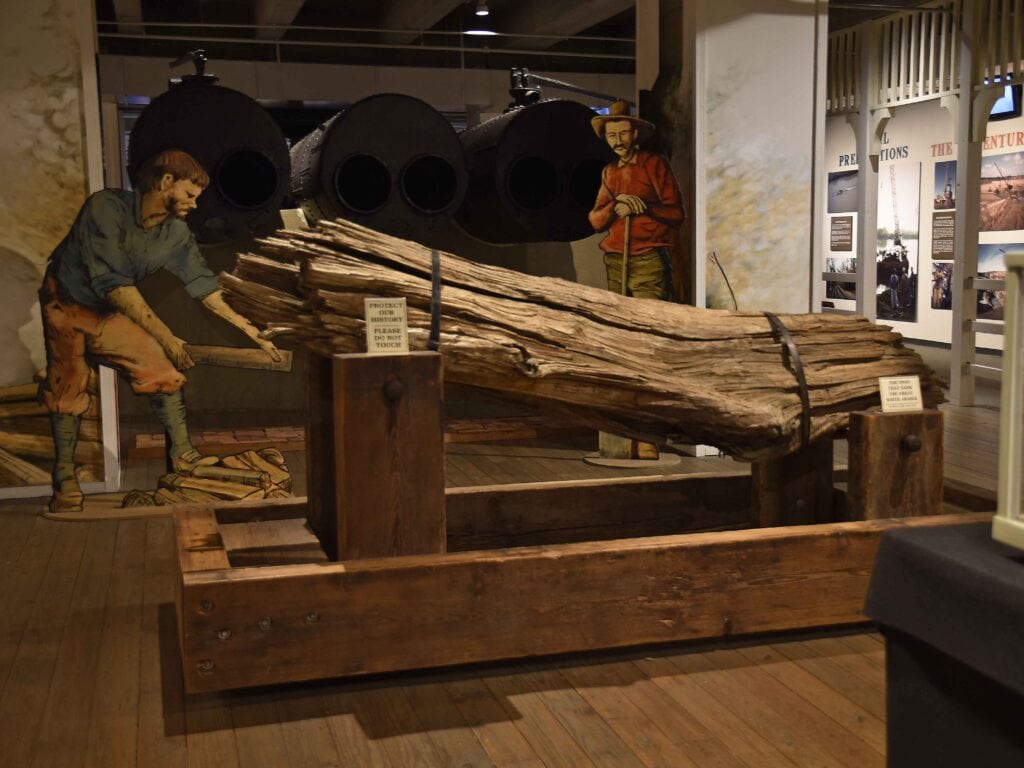
Creating a Legend
Each river journey opened ships up to unique dangers. Many steamboats were lost due to high-pressure boiler explosions. The rolling waters were constantly altering the riverbed. Rising and falling water levels uncovered new sandbars. In September 1856, Arabia struck a submerged snag at the Quindaro Bend, which is near Parkville, Missouri. Water rushed in through the hull, and the ship quickly sank. Passengers and crew scrambled to the upper decks to avoid drowning.

Unfortunate Passenger
In the end, all 130 people on board made it safely to shore. The only casualty from the accident was a mule that had been tethered to a lower floor. Forgotten in all of the confusion, it was left behind as the ship sank into the dark waters. It would be the 1980s before the Arabia would once again see daylight. Our visit to the Arabia Steamboat Museum began in the gift shop, where guests purchase their tickets. After descending a ramp to the gallery level, visitors will see the steam engine from the Missouri Packet. In 1820, this early ship was the first recorded steam-powered vessel to sink on the Missouri River.
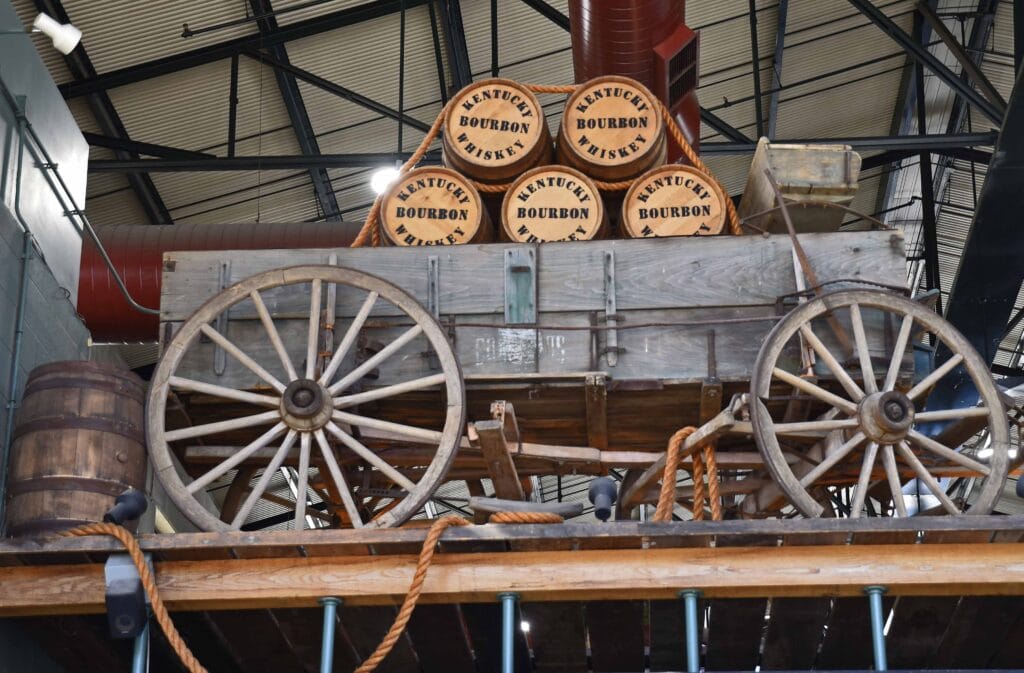
Arabia Steamboat Museum
Looking up, we spotted a wagon loaded with barrels of Kentucky Bourbon. It was rumored that this type of cargo was onboard Arabia, but none was recovered. The common belief is that if it had been part of the shipment, it was probably being stored up on the main deck. In that case, it would have floated away during the sinking of the ship. We continued into the main gallery area, where a description of the dig site was given, as well as seeing part of the stern on display.
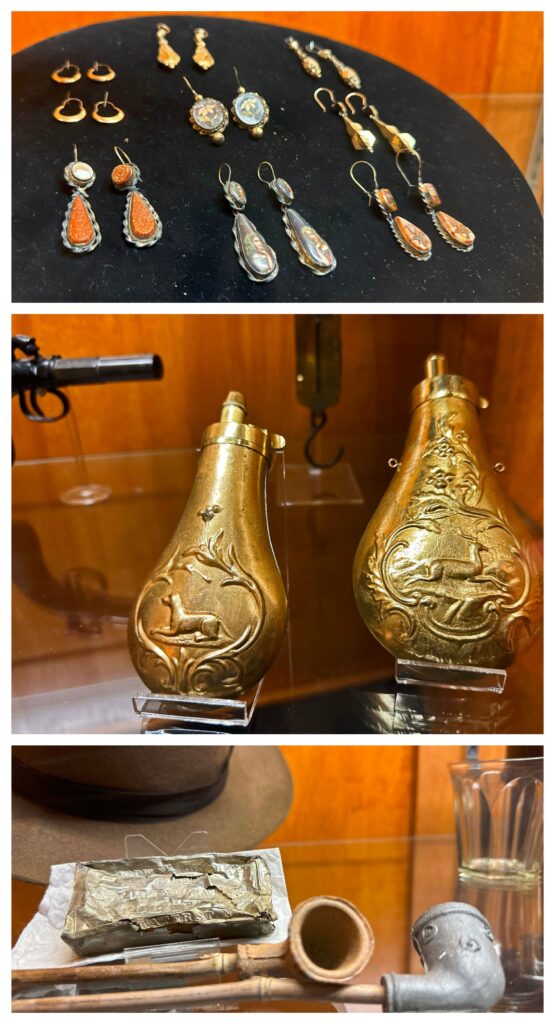
Artistic Artifacts
Passing into the exhibit galleries, we saw the huge paddlewheel slowly turning. We could almost imagine ourselves on the deck of a ship, traveling along the Muddy Missouri. This was the golden age of river travel and large amounts of cargo were transported to blossoming frontier towns. Arabia was 171 feet long and could carry over 200 tons of cargo. The sharp whistle would signal the arrival of a steamboat. Stopping at towns along the river, we can imagine the bustle of activity as ships were unloaded.
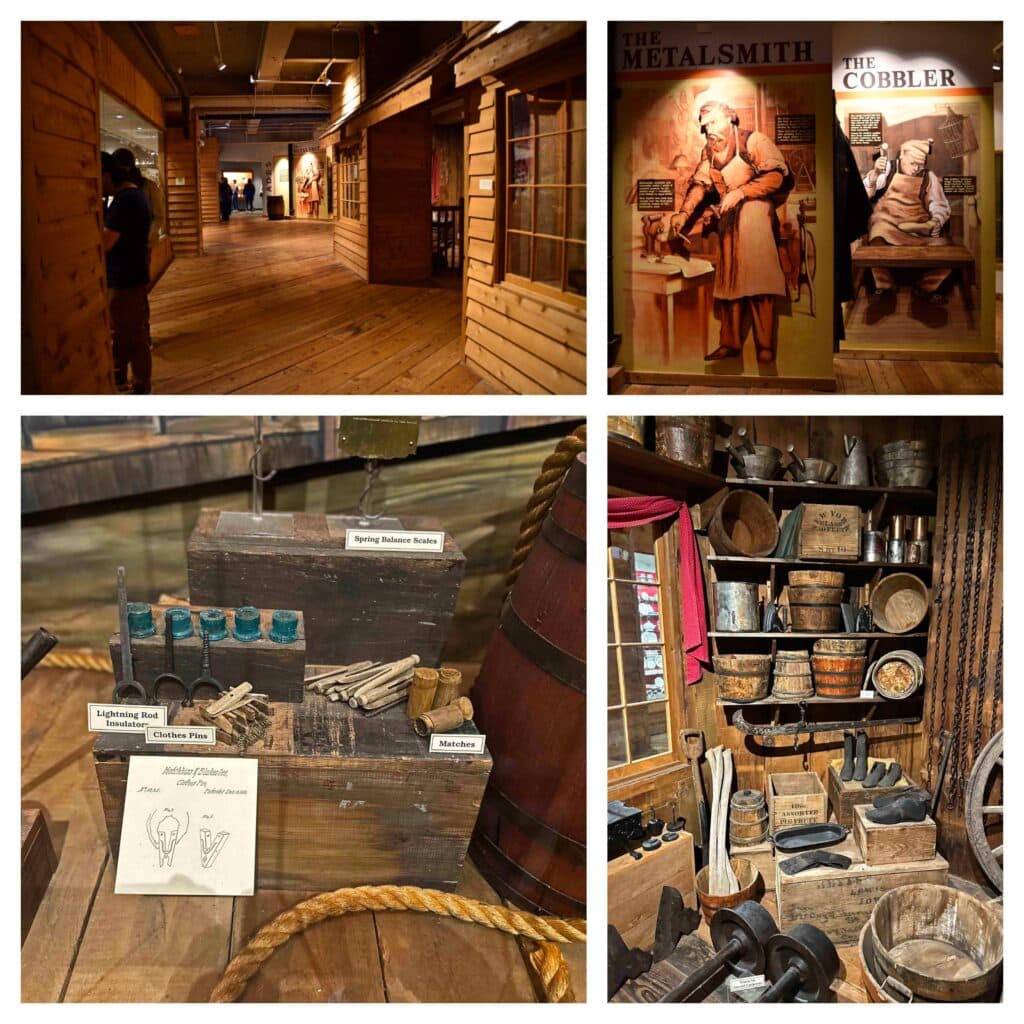
Craftsman Supplies
The Arabia Steamboat Museum is set up in an oval shape, and visitors work their way through at their own pace. The Arabia was carrying about 220 tons of goods at the time it sank. Most of this was destined for sixteen towns along the river. This left many frontier craftsmen without the materials needed to create their products.
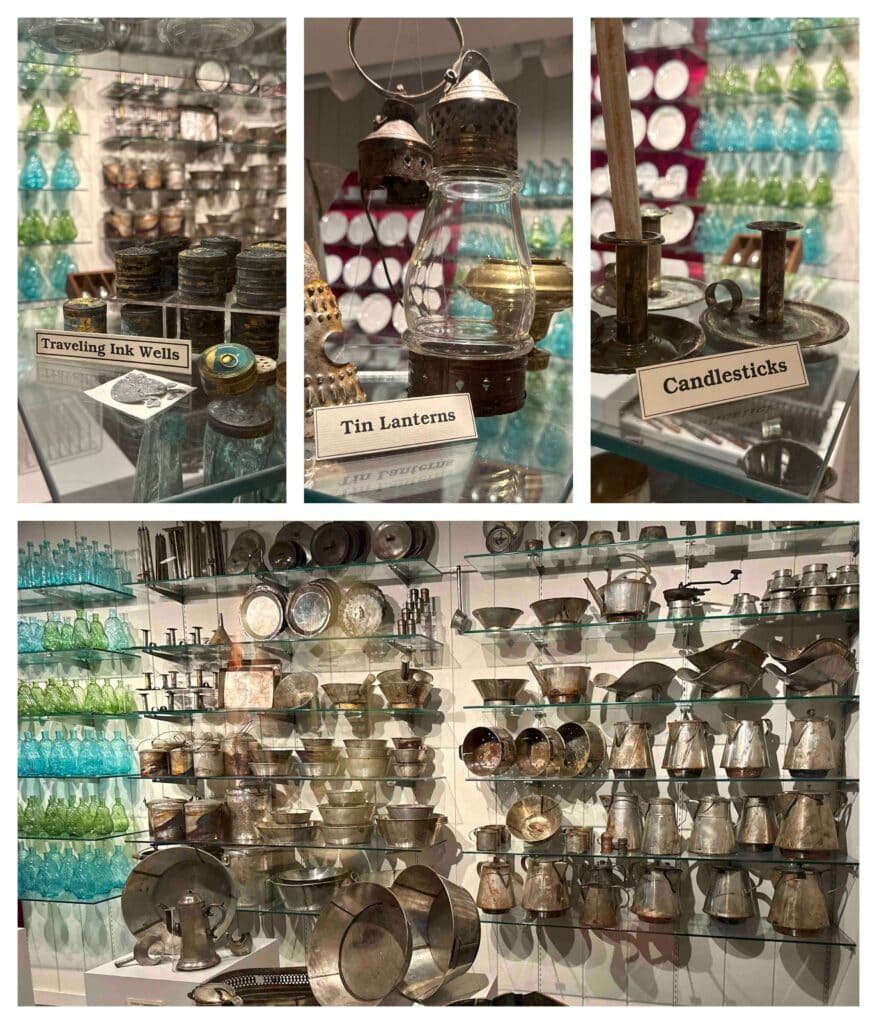
Daily Necessities
As we walked through the gallery, we saw massive displays of goods that looked almost new. There are rows upon rows of glassware, dishes, coffee pots, and other items used in daily life on the prairie. It’s hard to imagine these goods spent 152 years buried in the mud of a Wyandotte County cornfield. The Missouri River changed its course not long after the Arabia Steamboat sank. While many searched for the ship, it was not until 1988 that a group of treasure seekers located it.

Clothing Galore
The treasures of the Arabia Steamboat Museum include a wide range of products. Since the ship was scheduled to deliver to numerous frontier stores, you can imagine how broad the inventory was. As I looked out upon the vast supply, it made me wonder about the people in those small towns. Who knows how long they had been waiting for their supplies, only to discover them lost to the muddy Missouri River.

Oodles of Items
The various displays showcase the breadth of the inventory. Colorful glass bottles were filled with liquor and condiments. Preserved fruits for pie making were packed along with jars of sweet pickles. Buttons, beads, and tools were abundant. One display exhibit is filled with thousands of hardware pieces that would have been needed for the construction of homes and businesses.

The Work Continues
Not all of the merchandise recovered is even on display. After recovering all of the cargo, there was still the overwhelming task of preservation. During excavation, most of the pieces were frozen in blocks of ice. These were moved to freezers to maintain their condition. Each piece has to be meticulously cleaned, repaired and stabilized. To stabilize the leather and garment pieces, they were first soaked in preservatives and then freeze-dried on-site in the museum. While we were touring, we spotted a school group getting a tour. Staff explained the details of the restoration process to the eager crowd and we felt no shame listening in.

Visit Arabia Steamboat Museum
At the end of your visit, you can see the anchor and capstan that were used to hold the Arabia in place when it was at rest. It is a fitting end to the displays found in this one-of-a-kind museum. The Arabia Steamboat Museum is open 7 days a week, except for major holidays. Tours run every half hour, with the last one starting at 3:30. Admission is $16.50 for adults, and $15.50 for seniors 60 and older. Children 4 to 14 get in for $6.50, and younger than that are free. We found that about 1.5 to 2 hours are needed to check out all of the exhibits. It’s a great activity to add during a visit to the KC City Market.



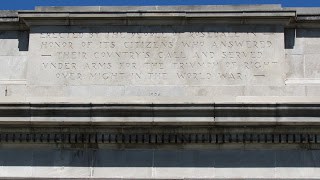


We have been away from the States for 3 years so far while traveling and visiting other countries. We are both history buffs and try to learn what we can about the places we visit. Once we return to the states, we are thinking of getting a ‘class A’ motorhome to travel the U.S. and we have just added the Arabia Steamboat Museum to our list.
We don’t think you will be disappointed. Travel safely.
Great history lesson – although tragic. I went to a similar exhibition about the Titanic – it was held in some hotel in Dublin. Many of the original objects such as plates, glasses and cutlery were displayed. Even original, still closed, bottles of wine that were taken out of the wreckage… Years later, I went to the famous Titanic exhibition in Belfast… and it was a great disappointment – it was so expensive and there were no original artifacts, only models and presentations…
Thank you for sharing your experience – I would love to see it – it seems authentic and very educational.
It was a great experience. Perhaps we will see the Titanic exhibit someday.
This is the kind of place you go and get out of there with a big head! So many things to learn, great history class! Would love to check it out when around!
Agree completely.
Talking about museums, I’m sure my husband will definitely be interested. The only reason why I visited museums because of him. Then eventually I got to appreciate museum collections, stories and history behind it. We’ll definitely check the Arabia Steamboat museum given the opportunity. 🙂
I believe my wife was the same way. Now she enjoys the stories about the people in history. Of course, she still dislikes war museums.
What an interesting and different place the Arabia Steamboat Museum is, and I truly feel like I’ve had a history lesson, especially not knowing much about that era in that part of the world – I’m super interesting to know if the bourbon floated away and who enjoyed it! The price doesn’t seem too bad either.
If the bourbon existed, I’m sure it was found by someone.
I am definitely not a fan of museums because I love adventure way more. I have been trying to appreciate the history more but they just seem so boring. Looks like you enjoyed yourself though and thats all that matters! 🙂
We like most museums. It’s great to learn the past.
Museums are a great place to learn history! It looks like a great place to learn about the Missouri River and the old river boats.
It certainly is.
Interesting experience, quite different from the usual travel ones. Always nice to read about such relatively unheard stories from the past. nicely written article with all the details.
Very unusual. Thanks for visiting our site.
Steamboat museums are really new to me. I feel they will be a great visit to the historical times and simultaneously will open our minds to the past tragedies. After going through your post, I am more keen to know where is Bourbon know.
Thanks for visiting our site. We hope you bookmark it for future visits.
It seems like an interesting experience that you guys have had. I am not really a museum person, i would rather go for an adventure trip 🙂
Adventure trips can be fun, as well.
Being a history fan, I feel, this is such a wonderful asset for everyone to learn about life back then! The extraordinary challenge to find, then recover, this amazing collection of items that could have been lost forever.
I do not know if schools still take youth on trips to locations relevant to their studies but this is a must go in my humble opinion.
Where can you see things frozen in time from a period long ago! The staff were so diligent in their perfect restoration and preservation of everything. I mean cloth, leather, wood metals absolutely like the day the Arabia sank!
PLEASE, PLEASE Kansas City support this treasure setting right there centrally located to the entire metro area!!!!!!!
A former Kansas City resident but forever a fan of this amazing family that worked so hard to find and recover the historical treasure!
Eddie Nash
We couldn’t have said it any better. This unique attraction is a treasure trove of history right in the heart of Kansas City.